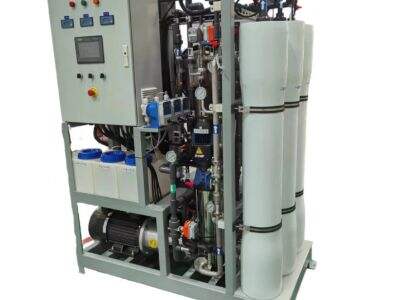This article covers essential things to consider when choosing seawater desalination equipment for your seawater cleaning needs. With so many different options, it can be difficult to find out exactly what will work best for you. That’s why it’s essential to know exactly what you need and how each kind of equipment functions. SIHE will help you find the best Desalination Equipment fit for your specific water treatment needs.
Types of Seawater Desalination Equipment: A Guide
You would probably see some different seawater desalination equipments and each type comes with its pluses and minuses. You must first learn of these different types before choosing which will serve you best.
Reverse osmosis system is one of the desalination equipment. This works by using a very special filter called a membrane. Salt and other impurities are filtered out by the membrane used by this technique which only allows clean water to go through. Reverse osmosis systems are specifically designed to efficiently and effectively treat seawater, and they are one of the most popular choices for many people and businesses providing seawater treatment.
You may also hear about distillation another system type of desalination plants. In this system, the seawater is boiled until it vapourises. As the seawater evaporates, the salt and impurities are left behind. The created steam is then gathered and cooled down again into water. Desalination systems, though, can also be effective in eliminating salt, but tend to be cost prohibitive for the purchase and operation, requiring large amounts of energy to heat the water.
Considerations for Equipment Selection
There are some factors that you need to keep in mind while choosing seawater desalination plants. A significant factor to consider is the equipment capacity. Capacity is how much water the system can purify per unit time. Whether it’s a large facility or a small household, you want to ensure your equipment is capable of performing the desalination for the quantity of water you require.
I will also touch on the efficiency of the equipment. Efficiency relates to the speed and effectiveness of the system at cleaning the water. You need to choose a system that can purify water easily and in a way that doesn’t consume energy. This keeps your operating costs lower, great news all around — for your wallet and the planet.
It’s also really important to consider how much care the equipment is going to need. As a result, certain configurations are in need of routine cleaning and maintenance in order to function properly, while others may need little to no attention at all. You’ll want to take these maintenance needs into consideration as you make your decision. Ensure that the equipment you select is compatible with your specific objectives for treating water.
Note: Checking Capacity and Efficiency
To assess the capacity and efficiency of desalination equipment, you need to consider the volume of water you regularly need to desalinate. For large water treatment facilities, you would need a higher machine in capacity so that it can meet the demand. However, there are plenty of options available for smaller systems that are more than capable of desalting water for a household, that are less costly and more suited for individual use.
That is also an important thing to think about. So you want to choose a system that can desalinate water as quickly as possible while consuming the least amount of energy it can. This will not only help you keep your costs low but also the equipment will be good for the environment. An efficiently running system will save you money over time and be a more sustainable option.
Cost and Maintenance Requirements Comparison
In order to assess the cost and maintenance requirements of the various desalination systems, it is necessary to examine the total equipment cost over its lifetime. Some systems are cheaper initially, but they may require a lot more maintenance and higher operating costs in the long run. It's good to consider these factors before finalizing your decision, so that you won't be surprised later down the line.
Maintenance requirements are a key factor in your decision-making process Others require ongoing servicing to function at their best. That could involve a cleaning of filters, a replacement of parts or a check for leaks. Important Factors To Consider When Selecting Fitness Equipment for Home:How much time and facilities you have for the maintainability of the Equipment. If it becomes too much maintenance for your needs for what—if it becomes too much maintenance for your needs it introduces problems into the future.
Making Sure It Aligns with Your Water Treatment Objectives
Finally, be sure to select desalination appropriate equipment for your specific water treatment goals and requirements. You have to ensure that the equipment is working for erasing salt and all other contaminants from the water so that you can get fresh water for consumption.
Moreover, think about what additional water treatment goals you might have, such as contaminant removal or taste improvement. While designing a Dasalination system you will want to select a system that can help you achieve these goals
Seawater Desalination Equipment: A Feeling, a Treatment, a Seal By understanding the different forms of desalination equipment, identifying their capacity, measuring their efficiency, comparing their costs versus maintenance requirements, and ensuring they meet your needs, you can discover the system to solve your needs. We at SIHE are ready to help you through every step of this process so you can look forward to many years of clean, fresh water.

